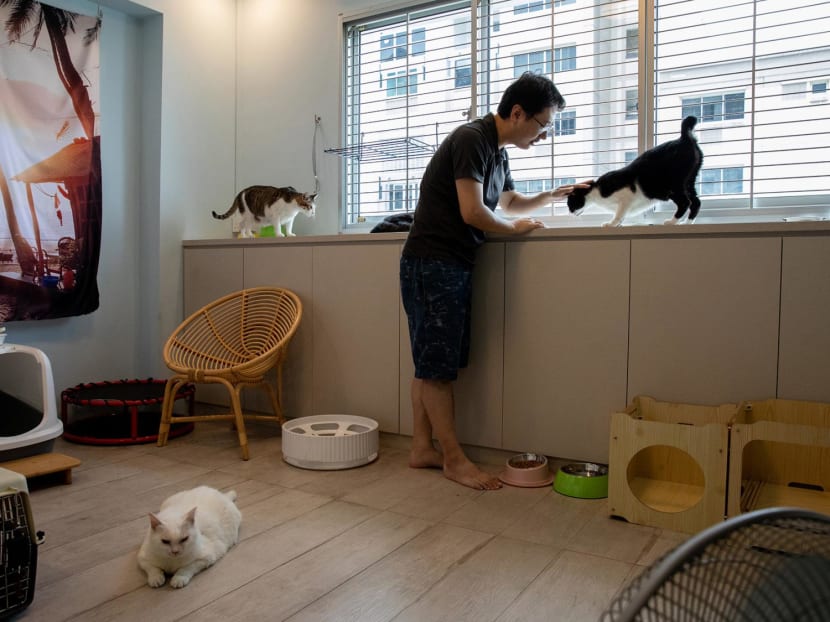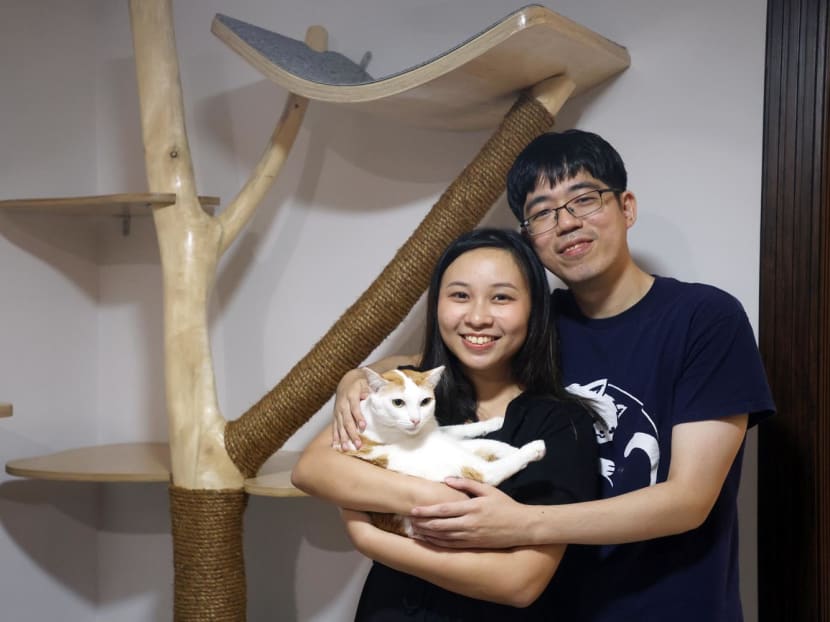The Big Read in short: Allowing pet cats in HDB flats — what are the boons and bumps?
SINGAPORE — For cat lover Shak, who lives in a two-room rental flat in Boon Lay with his mother, time is the biggest barrier to getting his three cats sterilised.

Pet cats have been banned in HDB flats for 34 years, due to concerns that the felines would cause disamenities to residents. A proposed cat management framework by the Animal and Veterinary Service will allow HDB households to own up to two cats from next year, if implemented.
Each week, TODAY’s long-running Big Read series delves into the trends and issues that matter. This week, we look at what a new proposed framework that will allow up to two cats to be kept as pets in Housing and Development Board households means. This is a shortened version of the full feature, which can be found here.
- Pet cats have been banned in HDB flats for 34 years, due to concerns that the felines would cause disamenities to residents, such as dirtying common areas and noise pollution
- A proposed cat management framework by the Animal and Veterinary Service will allow HDB households to own up to two cats from next year, if implemented
- Many cat owners and animal welfare groups welcome the proposal, though some others who are fearful of cats are concerned about the change
- Cat owners and animal welfare groups also highlighted some potential issues with the framework, such as the limit of two cats
- They added that one "critical omission" is the lack of mandatory sterilisation, which prevents unintended breeding and reduces disamenities
SINGAPORE — For cat lover Shak, who lives in a two-room rental flat in Boon Lay with his mother, time is the biggest barrier to getting his three cats sterilised.
The 39-year-old cat owner, who wanted to remain anonymous as owning a cat in a Housing and Development Board (HDB) flat is currently illegal, works part-time as a delivery attendant in the day and is a bouncer at night, leaving him with little free time.
While he is aware that sterilisation has many benefits, the cost of the procedure is also a concern, as he tries to use more affordable methods to care for his cats, such as buying cat food in Johor Bahru and cat-proofing his gate with corrugated board from his workplace.
Mr Shak is one of many cat owners who know that looking after pets is not just a labour of love.
It also involves mindful financial planning and consideration for neighbours, especially when living in a HDB environment where a ban on cat ownership has been in place for more than three decades.
Ms Kimberly Chan, a 32-year-old marketing manager, does her “due diligence” to mesh exits so her four cats do not escape. She is unsure if her neighbours know that she has cats, since the felines are typically quiet and kept inside.
However, despite some owners’ best efforts, several HDB residents told TODAY that negative experiences with cats have left them hesitant or even averse to lifting the ban on pet cats.
Ms Jean Koh, who works in real estate and has a fear of cats since her childhood, said that having cats in HDB flats “creates a very uncomfortable situation” for those who are averse to such pets.
For the 45-year-old, it is “already stressful” to see community cats on a daily basis and a legalisation of cats in HDB flats, which could allow her neighbours to own cats, would be "too close for comfort”.
Since 1989, HDB dwellers have not been permitted to house pet cats, and offenders may be fined up to S$4,000 if found to have a pet cat in their flat under the Housing and Development (Animals) Rules.
While the ban on cats in flats has been the subject of heated perennial debate, HDB said it was put in place because cats are “generally difficult to contain within the flat”.
“When allowed to roam indiscriminately, they tend to shed fur and defecate or urinate in public areas, and also make caterwauling sounds, which can inconvenience your neighbours,” it added.

After the release of results from a public consultation launched in 2022 in May this year, Senior Minister of State for National Development Tan Kiat How announced on Dec 2 a proposed cat management framework by the National Parks Board’s Animal and Veterinary Service (AVS).
When implemented in the later part of 2024, the proposal will allow up to two cats in HDB flats and introduce mandatory licensing and microchipping for pet cats.
WHY IT MATTERS
The proposal follows AVS’ public consultation exercise on the framework, which garnered over 30,000 responses from September to November last year.
Close to 90 per cent of respondents said cats are suitable pets, with most of them also supporting cats being kept as pets in HDB flats.
The survey also found that over 80 per cent agreed that pet cats should be microchipped and licensed as licencing could improve the health, welfare and traceability of cats.
In response to TODAY’s queries, HDB said it works with other agencies and animal welfare groups to engage flat owners after it receives complaints about “unpermitted and irresponsible pet ownership in HDB flats”.
Over the past three years, the number of cat-related feedback received by HDB from residents had gone down. HDB received around 1,900 cases in 2020, 1,500 cases in 2021 and 1,300 complaints in 2022.
HDB takes legal action against flat owners only as a “last resort”. Only two households have been fined since 2020 after failing to cooperate and rehome their cats which caused disamenities.
THE BIG PICTURE
Under the proposed cat management framework, AVS limits household pets to:
- Two cats (and one dog of an approved breed, as per current limits) for each HDB flat
- Three cats or dogs, or a combination of three pets in total, for each private premise
- Additional pet licences will be subject to AVS’ approval, and HDB’s approval for HDB residents
During a two-year transition period, cat owners can apply to license and keep all existing pet cats. All pet cats will have to be microchipped before they can be licensed.
First-time licence applicants will have to complete a free online responsible pet ownership course, which will cover topics such as basic pet care skills and responsible pet ownership in the four vernacular languages.
It will be an offence to keep unlicensed pet cats after the transition period.
For married cat owners and independent rescuers Iris Ng and Than Yan Ren, the proposed cat management framework and legalisation of cats in HDB flats brings some relief.
Ms Ng, 32, a sustainability manager, said she had always been conscious of the ban, which made their decision to adopt their cat “very stressful”.
The ban imposed challenges such as difficulty securing pet insurance as some insurers do not allow a cat owner's listed address to be a HDB flat and social concerns of being unable to openly establish a cat owner community in her neighbourhood.

Ms Shelby Doshi, a cat behavioural consultant, said the ban reversal is “long overdue” and many cats are already living in HDB flats, and the proposed framework, though still needing areas for improvement, would be part of “little steps to great progress”.
Ms Aarthi Sankar, executive director of the Society for the Prevention of Cruelty to Animals (SPCA) said that mandating meshing of windows and gates, keeping cats strictly indoors and sterilisation are other areas that could better ensure responsible cat ownership in flats.
For some people like cat fosterer James Wong, the cap of two is on the “low end” as cats are “social animals”.
Many people who started out adopting a single cat from him average out at three or more cats after some time, and cat rescuers may have more.
Mr Wong, who is a 41-year-old senior finance manager and has rescued and rehomed many cats, is also concerned that the proposed cap will cut off the supply of “good adopters”, who may hesitate to adopt another cat despite having the means.
Both SPCA and Cat Welfare Society, which has for years advocated for cats to be allowed as pets in HDB flats, cited concerns over possible misunderstanding of the proposed threshold of two licensed cats.
“There is a risk that irresponsible cat owners with more than the proposed threshold number of cats might look to abandon or recklessly give their cats away without realising they can get licences for more than the threshold number of cats during the transition period provided they are responsible,” said Ms Thenuga Vijakumar, president of CWS.
THE BOTTOM LINE
Many cat owners and animal welfare groups told TODAY that sterilisation of cats is a priority for responsible pet ownership, and urged for mandatory sterilisation to be a licensing condition included in the proposed framework.
Ms Thenuga said: “Sterilisation also helps minimise certain behaviours such as caterwauling, indiscriminate roaming and spraying to mark territory. These are the very reasons cited by HDB for not allowing cats in flats in the first place.”
Ms Aarthi added: “The suggested framework aims to reduce hoarding by setting a cap on the number of cats allowed per household. However, a critical omission in this framework is the lack of a mandate for cat sterilisation.”
While she acknowledged that the framework is a “start” and not “perfect”, Ms Kerstin Schulze from Project Luni said that mandatory sterilisation should be “non-negotiable”.
“We see the results of people’s cats accidentally having litter after litter or unsterilised roaming cats contributing to kittens being born on the street on a daily basis and it breaks our hearts,” she said.

On the cap of two cats per household, AVS director Audrey Chen, said that the proposed limit was based on “assimilating the information” from public feedback and the need to balance preferences.
Ensuring that the community “remains harmonious” is a priority and while there are no immediate plans to change the proposed limit, AVS would be open to feedback and review depending on the future landscape, she said.
On why mandatory sterilisation is not a proposed licensing condition for cats, Dr Chen said AVS “strongly encourages” sterilisation as it recognises the health and behavioural benefits of the procedure.
Under the proposed framework, sterilisation is incentivised during the two-year transition period, where cat owners who sterilise their cats will have free cat licences with lifetime validity.
Those who do not sterilise their cats will have to regularly renew their licences at a higher fee following the two-year transition period.
Dr Chen said AVS would take a “stepwise approach” to allow cat owners to adjust to the proposed changes, and review the framework based on the survey results and during its implementation over the next few years.
The public can share feedback on the proposed framework through an online survey at https://go.gov.sg/cat-framework until Feb 1 next year.











